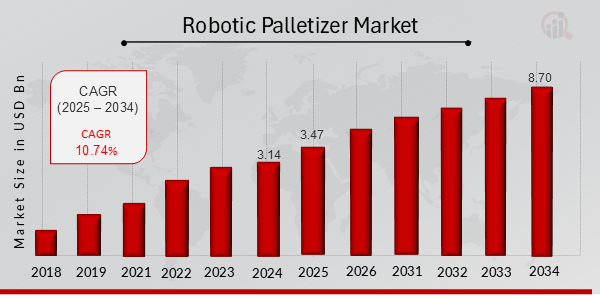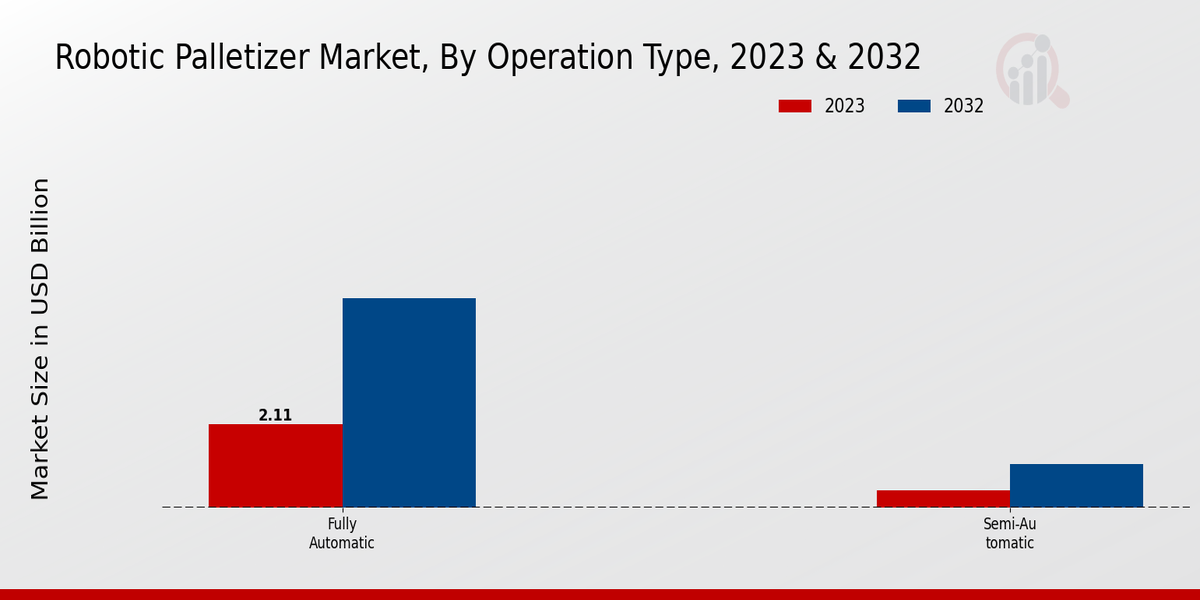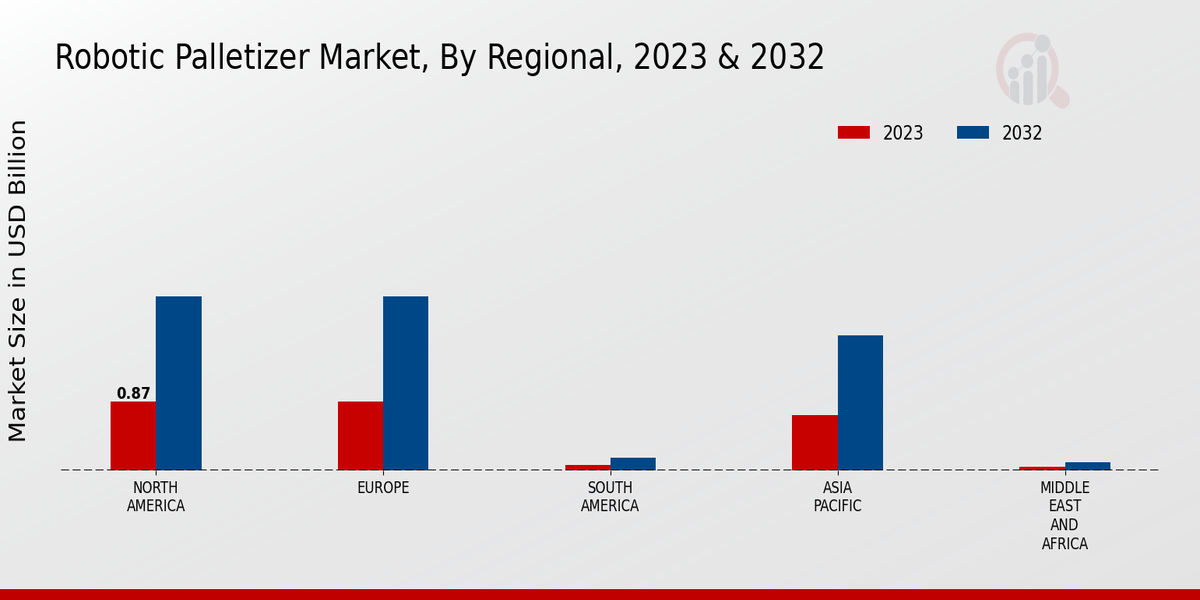Robotic Palletizer Market Overview:
As per MRFR analysis, the Robotic Palletizer Market Size was estimated at 3.14 (USD Billion) in 2024. The Robotic Palletizer Market Industry is expected to grow from 3.47 (USD Billion) in 2025 to 8.70 (USD Billion) till 2034, at a CAGR (growth rate) is expected to be around 10.74% during the forecast period (2025 - 2034).
Key Robotic Palletizer Market Trends Highlighted
The Robotic Palletizer market has been growing at a faster pace over the last few years. Prominent among market influencers is the growing industry appetite for automation, the demand for increasing productivity and efficiency, and the adoption of futuristic technologies. There exists a possibility for further development combining robotics with artificial intelligence (AI) as well as designing specific palletizing equipment for particular industries.
The current advancements are also seen in the use of collaborative robots, which are able to operate in close proximity with human employees, in addition to the use of automated guided vehicles (AGVs) in movement systems. This market is anticipated to maintain this rapid growth rate as new dimensionalities are brought up by the new dynamic changes of industries wanting comprehensive and smart palletizing systems.

Source: Primary Research, Secondary Research, MRFR Database and Analyst Review
Robotic Palletizer Market Drivers
Growing Demand for Automation in Warehouses and Distribution Centers
One of the key factors that are driving the Robotic Palletizer Market Industry is the rising demand for automation in warehouses and distribution centers. Implementing robotic palletizers in businesses’ operations allows them to work more quickly and effectively and reduces the need to hire extra workers. Also, robotic palletizers can work 24 hours a day, 7 days a week, without having breaks or getting tired. This is highly beneficial for businesses that wish to maximize their throughput and productivity.
In addition, nowadays, due to the rising popularity of e-commerce, there are more online orders than ever before. For this reason, there is a growing demand for automated palletizing solutions as businesses aim to meet the increasing customer demand for quick and efficient order delivery.
Advancements in Robotics and Artificial Intelligence
Moreover, owing to the large scope of application of AI and machine learning in a robotic palletizing system, their demand is anticipated to remain high even in the upcoming decades, thereby propelling the growth of the Robotic Palletizer Market Industry. With robotic palletizers becoming increasingly sophisticated, they can carry out a multitude of operations, ranging from simple pick-and-place tasks to more complex applications, such as handling asymmetrical and odd-sized products and operating at high speeds.
Thanks to the implementation of advanced automation and robotics solutions, these machines require no manual intervention or supervision and, as a result, contribute to a significant decrease in staff-related and production downtime costs.
Rising Labor Costs and Shortage of Skilled Workers
The increasing labor costs and limited supply of skilled workers are other factors fuelling the development of the Robotic Palletizer Market Industry. A robotic palletizer requires one-time installation and minimal maintenance in contrast to employing a workforce that fills the same roles and demands training and re-training from time to time. Most importantly, switching from manual to robotic palletizing reduces a business’s need for employees and the manual factory’s susceptibility to robot labor shortages, robotic joint seals ensuring it maintains its efficiency and competitiveness.
Robotic Palletizer Market Segment Insights:
Robotic Palletizer Market Operation Type Insights
The Robotic Palletizer Market is segmented by Operation Type into Fully Automatic and Semi-Automatic. In 2023, the Fully Automatic segment held the largest share of the market, and it is expected to continue to dominate the market in the forecast period. This can be explained by the increased adoption of automation by various industries, such as food, beverage, pharmaceuticals, and logistics.
Fully automatic robotic palletizers can offer a number of benefits over manual palletizing, such as higher efficiency, lower labor costs, and better safety. At the same time, the Semi-Automatic segment is expected to have a higher CAGR in the forecast period. This can be attributed to the increasing demand for affordable automation solutions, which is especially relevant for small and medium-sized enterprises. The main drivers of this growth are the increasing need for automation in multiple industries, the growing adoption of Industry 4.0 technologies, and the increasing demand for affordable and effective palletizing solutions.

Source: Primary Research, Secondary Research, MRFR Database and Analyst Review
Robotic Palletizer Market Pallet Type Insights
In the Robotic Palletizer Market, pallet type segmentation holds significant importance, with Standard Pallets and Custom Pallets commanding substantial market shares. Standard Pallets, adhering to industry-standard dimensions and specifications, are widely used across various industries due to their versatility and cost-effectiveness. Custom Pallets, tailored to specific product requirements and handling needs, offer enhanced stability and protection for specialized goods.
The Robotic Palletizer Market for Standard Pallets is projected to grow steadily, driven by the increasing adoption of automation in warehouses and distribution centers. Custom Pallets, catering to niche applications are expected to witness a surge in demand from industries seeking customized solutions for their unique requirements. Overall, the segmentation of the Robotic Palletizer Market by Pallet Type provides valuable insights into the market dynamics, enabling stakeholders to make informed decisions and capitalize on growth opportunities.
Robotic Palletizer Market End-Use Industry Insights
The Robotic Palletizer Market is segmented into various end-use industries, including food and beverage, pharmaceuticals, manufacturing, and logistics. Among these, the food and beverage industry holds a significant share of the market due to the increasing demand for automated palletizing solutions in food processing and packaging operations.
The growth in the e-commerce sector has also contributed to the rising demand for robotic palletizers in the logistics industry. Furthermore, the pharmaceutical industry is expected to witness steady growth in the adoption of robotic palletizers as they ensure precision and efficiency in handling sensitive pharmaceutical products. The manufacturing industry, particularly automotive and electronics, is also witnessing a growing adoption of robotic palletizers to optimize production processes and improve productivity.
Robotic Palletizer Market Robot Type Insights
The Robotic Palletizer Market is segmented by Robot Type into Cartesian Robots, Articulated Robots, and SCARA Robots. Among these, Cartesian Robots held the largest market share in 2023, accounting for over 40% of the Robotic Palletizer Market revenue. The market growth of Cartesian Robots is attributed to their simple design, high accuracy, and cost-effectiveness.
Articulated Robots are expected to witness a significant CAGR during the forecast period, owing to their increased flexibility and ability to handle complex palletizing tasks.SCARA Robots are ideal for high-speed and precision palletizing applications and are gaining popularity in the food and beverage industry. The Robotic Palletizer Market segmentation provides valuable data and insights for market players to develop effective strategies and make informed decisions.
Robotic Palletizer Market Payload Capacity Insights
The payload capacity segment in the Robotic Palletizer Market holds significant importance, influencing the market growth trajectory. The segment is categorized into three sub-segments: ' 1000 kg', '1000-2000 kg', and '> 2000 kg'. The ' 1000 kg' sub-segment accounted for a considerable revenue share in 2023 and is projected to maintain a steady growth rate during the forecast period. This sub-segment caters to industries with lightweight palletized goods, such as food and beverage, pharmaceuticals, and consumer electronics.
The '1000-2000 kg' sub-segment is anticipated to witness robust growth, driven by increasing demand for robotic palletizers in industries such as automotive, building materials, and logistics. These palletizers are suitable for handling medium-weight goods, offering efficient and reliable palletizing operations. The '> 2000 kg' sub-segment is expected to gain significant traction during the forecast period. This sub-segment caters to heavy industries such as metalworking, mining, and construction, where robotic palletizers are essential for handling heavy loads and ensuring safety and productivity.
The growth of the payload capacity segment is attributed to factors such as rising automation adoption in various industries, increasing demand for efficient palletizing solutions, and growing awareness about the benefits of robotic palletizers, including improved safety, reduced labor costs, and increased productivity.
Robotic Palletizer Market Regional Insights
The Regional segment of the Robotic Palletizer Market holds significant importance, offering valuable insights into the geographical distribution of market growth and opportunities. North America leads the market with a substantial share, driven by the presence of major players and advanced manufacturing industries. Europe follows closely, with a robust automotive and food-beverage sector.
APAC is expected to witness the highest growth rate over the forecast period, owing to rapidly expanding economies and increasing automation adoption in manufacturing. South America and MEA represent emerging markets with untapped potential for robotic palletizers, as industries in these regions seek to enhance efficiency and productivity. The Robotic Palletizer Market revenue is projected to reach $2.56 billion in 2023 and is anticipated to expand at a CAGR of 10.74%, reaching $6.4 billion by 2032.

Source: Primary Research, Secondary Research, MRFR Database and Analyst Review
Robotic Palletizer Market Key Players And Competitive Insights:
Major players in the Robotic Palletizer Market industry are continuously involved in developing advanced technologies to maintain their position in the market. Leading Robotic Palletizer Market players emphasize strategic partnerships and collaborations to enhance their product portfolio and expand their market reach. Market players focus on providing innovative solutions tailored to specific industry requirements to gain a competitive edge. Mergers and acquisitions are prevalent as companies seek to strengthen their market position and expand their service offerings. Companies invest in research and development to stay abreast of technological advancements and fulfill ever-changing customer demands. They also prioritize sustainability initiatives to reduce their environmental impact while maintaining operational efficiency.
A leading player in the Robotic Palletizer Market, Fanuc holds a prominent position in the industry owing to its comprehensive product portfolio and established customer base. With a strong focus on innovation, the company continually enhances its robotic palletizing solutions to meet evolving market needs. Fanuc's commitment to customer satisfaction is evident through its extensive support network and aftermarket services.
The company has a global presence, catering to diverse industries such as automotive, food and beverage, and manufacturing. Its strategic partnerships and collaborations with leading solution providers enable Fanuc to offer integrated automation solutions tailored to specific customer requirements. Kuka, another major player in the Robotic Palletizer Market, stands out with its technologically advanced robotic palletizing systems. The company's commitment to research and development has resulted in innovative solutions addressing the challenges of complex and demanding applications.
Kuka offers a wide range of robotic palletizers to cater to various industries, including logistics, automotive, and pharmaceuticals. Its focus on ergonomic design ensures the well-being and safety of operators, enhancing overall productivity. Kuka's global presence and extensive service network ensure timely support and maintenance for its customers. The company's strategic partnerships with system integrators and end-users enable it to provide comprehensive solutions tailored to specific industry requirements.
Key Companies in the Robotic Palletizer Market Include:
- Mitsubishi Electric Corporation
- Sepro Group
- Stäubli International AG
- Kawasaki Robotics (USA), Inc.
- Kawasaki Heavy Industries, Ltd.
- Kuka AG
- NachiFujikoshi Corporation
- Fanuc Corporation
- Yaskawa Electric Corporation
- Omron Corporation
- Epson Robots
- Universal Robots A/S
- Comau S.p.A
- ABB Group
Robotic Palletizer Market Industry Developments
The global robotic palletizer market is projected to reach USD 6.4 billion by 2032, exhibiting a CAGR of 10.74% during the forecast period (2025-2034). The growing demand for automation in the manufacturing and logistics industries is driving market expansion. Robotic palletizers enhance efficiency, reduce labor costs, and improve safety in various end-use sectors, including food, beverage, pharmaceuticals, and automotive.
Recent developments in the market include the launch of collaborative robotic palletizers, which can safely work alongside human workers. Additionally, advancements in artificial intelligence (AI) and machine learning (ML) are enabling robotic palletizers to handle complex tasks and adapt to changing production requirements.
E-commerce growth is also fueling demand for robotic palletizers as companies seek to automate their order fulfillment processes. The increasing adoption of Industry 4.0 technologies is further driving market expansion as manufacturers integrate robotic palletizers into their smart factories.
Robotic Palletizer Market Segmentation Insights
-
Robotic Palletizer Market Operation Type Outlook
- Fully Automatic
- Semi-Automatic
-
Robotic Palletizer Market Pallet Type Outlook
- Standard Pallets
- Custom Pallets
-
Robotic Palletizer Market End-Use Industry Outlook
- Food and Beverage
- Pharmaceuticals
- Manufacturing
- Logistics
-
Robotic Palletizer Market Robot Type Outlook
- Cartesian Robots
- Articulated Robots
- SCARA Robots
-
-
Robotic Palletizer Market Payload Capacity Outlook
- 1000 kg
- 1000-2000 kg
- > 2000 kg
-
Robotic Palletizer Market Regional Outlook
- North America
- Europe
- South America
- Asia Pacific
- Middle East and Africa
| Report Attribute/Metric |
Details |
|
Market Size 2024
|
3.14 (USD Billion)
|
|
Market Size 2025
|
3.47 (USD Billion)
|
|
Market Size 2034
|
8.70 (USD Billion)
|
|
Compound Annual Growth Rate (CAGR)
|
10.74% (2025 - 2034)
|
|
Report Coverage
|
Revenue Forecast, Competitive Landscape, Growth Factors, and Trends
|
|
Base Year
|
2024
|
|
Market Forecast Period
|
2025 - 2034
|
|
Historical Data
|
2019 - 2023
|
| Market Forecast Units |
USD Billion |
| Key Companies Profiled |
Mitsubishi Electric Corporation, Sepro Group, Stäubli International AG, Kawasaki Robotics (USA), Inc., Kawasaki Heavy Industries, Ltd., Kuka AG, Nachi-Fujikoshi Corporation, Fanuc Corporation, Yaskawa Electric Corporation, Omron Corporation, Epson Robots, Universal Robots A/S, Comau S.p.A, ABB Group |
| Segments Covered |
Operation Type, Pallet Type, End-Use Industry, Robot Type, Payload Capacity, Regional |
| Key Market Opportunities |
Increase in demand from the food and beverage industry. Growing adoption in e-commerce and logistics sectors Automation of material handling processes Advancements in robotics and technology Focus on improving safety and efficiency in warehouses and distribution centers. |
| Key Market Dynamics |
Rise of e-commerce Growing demand for automation Advancements in AI and robotics Labor shortages Increasing focus on efficiency |
| Countries Covered |
North America, Europe, APAC, South America, MEA |
Frequently Asked Questions (FAQ) :
The Robotic Palletizer Market is expected to reach USD 8.70 billion by 2034, growing at a CAGR of 10.74% from 2025 to 2034. The market was valued at USD 3.14 billion in 2024.
North America is expected to hold the largest market share in the Global Robotic Palletizer Market during the forecast period. The Asia Pacific region is expected to be the fastest-growing market due to the increasing adoption of automation in manufacturing and logistics industries.
Some of the key competitors in the Global Robotic Palletizer Market include ABB, FANUC, KUKA, YASKAWA, and Kawasaki.
Robotic Palletizers are used in a wide range of applications, including food and beverage, automotive, pharmaceutical, and logistics.
The key growth factors driving the Global Robotic Palletizer Market include the increasing demand for automation in manufacturing and logistics industries, the rising labor costs, and the need for improved efficiency and productivity.
The challenges faced by the Global Robotic Palletizer Market include the high cost of robotic palletizers, the lack of skilled labor to operate and maintain them, and concerns about safety.
Some of the emerging trends in the Global Robotic Palletizer Market include the increasing adoption of collaborative robots, the development of AI-powered palletizers, and the growing use of cloud-based software for remote monitoring and control.
The key opportunities in the Global Robotic Palletizer Market include the increasing demand for automation in emerging markets, the growing adoption of e-commerce, and the need for sustainable solutions.

















